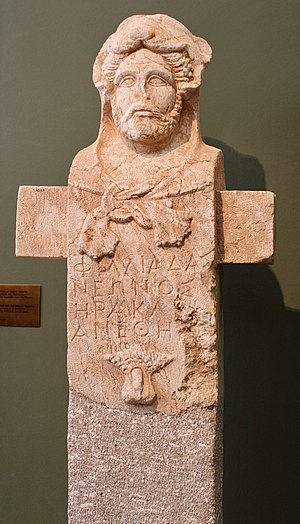Hermeracles: Difference between revisions
χλανίσι δὲ δὴ φαναῖσι περιπεπεµµένοι καὶ µαστίχην τρώγοντες, ὄζοντες µύρου. τὸ δ’ ὅλον οὐκ ἐπίσταµαι ἐγὼ ψιθυρίζειν, οὐδὲ κατακεκλασµένος πλάγιον ποιήσας τὸν τράχηλον περιπατεῖν, ὥσπερ ἑτέρους ὁρῶ κιναίδους ἐνθάδε πολλοὺς ἐν ἄστει καὶ πεπιττοκοπηµένους → Dressed up in bright clean fine cloaks and nibbling pine-thistle, smelling of myrrh. But I do not at all know how to whisper, nor how to be enervated, and make my neck go back and forth, just as I see many others, kinaidoi, here in the city, do, and waxed with pitch-plasters.
mNo edit summary |
m (Text replacement - "(?s)(==Wikipedia EN==)(\n)(.*$)" to "{{wkpen |wketx=$3 }}") |
||
| (2 intermediate revisions by the same user not shown) | |||
| Line 1: | Line 1: | ||
{{Lewis | {{Lewis | ||
|lshtext=<b>Hermēracles</b>: is, m., = [[Ἑρμῆς]]-Ἡρακλῆς,<br /><b>I</b> a [[double]] [[bust]] of [[Mercury]] and [[Hercules]], Cic. Att. 1, 10, 3. | |lshtext=<b>Hermēracles</b>: is, m., = [[Ἑρμῆς]]-[[Ἡρακλῆς]],<br /><b>I</b> a [[double]] [[bust]] of [[Mercury]] and [[Hercules]], Cic. Att. 1, 10, 3. | ||
}} | }} | ||
[[File:HermHerakles 2.jpg|thumb|Herma with the head of Herakles (Hermherakles). Museum of Ancient Messene, Greece|alt=Herma with the head of Herakles (Hermherakles). Museum of Ancient Messene, Greece.]] | |||
{{Gaffiot | {{Gaffiot | ||
|gf=<b>Hermērāclēs</b>, is, m. ([[Ἑρμηρακλῆς]]), buste représentant à la fois Mercure et Hercule : Cic. Att. 1, 10, 3. | |gf=<b>Hermērāclēs</b>, is, m. ([[Ἑρμηρακλῆς]]), buste représentant à la fois Mercure et Hercule : Cic. Att. 1, 10, 3. | ||
}} | }} | ||
{{Georges | {{Georges | ||
|georg=Hermērāclēs, is, m. ( | |georg=Hermērāclēs, is, m. ([[Ἑρμηρακλῆς]]), [[Merkur]] u. Herkules [[auf]] einem Postamente [[stehend]], Akk. Plur. [[Hermeracles]], Cic. ad Att. 1, 10, 3. | ||
}} | |||
{{wkpen | |||
|wketx=A [[herma]] (Ancient Greek: [[ἑρμῆς]], pl. ἑρμαῖ hermai), commonly [[herm]] in English, is a sculpture with a head and perhaps a torso above a plain, usually squared lower section, on which male genitals may also be carved at the appropriate height. Hermae were so called either because the head of Hermes was most common or from their etymological connection with the Greek word ἕρματα (blocks of stone), which originally had no reference to Hermes at all. The form originated in ancient Greece, and was adopted by the Romans, and revived at the Renaissance in the form of term figures and atlantes. | |||
}} | }} | ||
Latest revision as of 12:48, 24 October 2022
Latin > English (Lewis & Short)
Hermēracles: is, m., = Ἑρμῆς-Ἡρακλῆς,
I a double bust of Mercury and Hercules, Cic. Att. 1, 10, 3.
Latin > French (Gaffiot 2016)
Hermērāclēs, is, m. (Ἑρμηρακλῆς), buste représentant à la fois Mercure et Hercule : Cic. Att. 1, 10, 3.
Latin > German (Georges)
Hermērāclēs, is, m. (Ἑρμηρακλῆς), Merkur u. Herkules auf einem Postamente stehend, Akk. Plur. Hermeracles, Cic. ad Att. 1, 10, 3.
Wikipedia EN
A herma (Ancient Greek: ἑρμῆς, pl. ἑρμαῖ hermai), commonly herm in English, is a sculpture with a head and perhaps a torso above a plain, usually squared lower section, on which male genitals may also be carved at the appropriate height. Hermae were so called either because the head of Hermes was most common or from their etymological connection with the Greek word ἕρματα (blocks of stone), which originally had no reference to Hermes at all. The form originated in ancient Greece, and was adopted by the Romans, and revived at the Renaissance in the form of term figures and atlantes.

